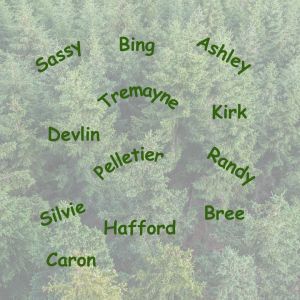What’s in a Name?
Plot, setting, characters, all of those elements go into creating a story. Plot and setting usually complement each other. Although, it’s true I’ve been colder in Florida than I ever was in Maine and hotter in Maine than I ever was in Florida. Last week, anyone? That’s the exception, and used well, an ingredient that creates conflict. Playing against expectation is always fun.
 Characters are the bane of my existence. Not creating them. They usually arrive full-blown, warts and all. Naming them is my problem. I often want to shake them and beg them to tell me who they are. Instead, they laugh. Outside of fiction, I have never named a human being. And my friends who have had children stuck with family names. Precious little help there. As an author, Uncle Bancroft may have a place in the family hierarchy, but as a character, not so much. At least not without explanation. The only way I can picture him is sitting behind a mahogany partner’s desk puffing on a cigar. Great if I wrote British-style novels, not so good for the north woods of Maine or the Florida Keys.
Characters are the bane of my existence. Not creating them. They usually arrive full-blown, warts and all. Naming them is my problem. I often want to shake them and beg them to tell me who they are. Instead, they laugh. Outside of fiction, I have never named a human being. And my friends who have had children stuck with family names. Precious little help there. As an author, Uncle Bancroft may have a place in the family hierarchy, but as a character, not so much. At least not without explanation. The only way I can picture him is sitting behind a mahogany partner’s desk puffing on a cigar. Great if I wrote British-style novels, not so good for the north woods of Maine or the Florida Keys.
There are two major considerations for naming characters. Location and generation. Saddling a character with a certain name evokes expectation. For example, when I was a kid, my mom bought me a Barbie game. Bear in mind, this was the early 1960s. The potential boyfriend names were Ken, Tom, Bob, and, inexplicably, Poindexter. No player willingly selected Poindexter. Even to a bunch of eight-year-olds, the name screamed nerd. I often wonder if Dexter Morgan’s first name wasn’t Poindexter. Look where it got him. Yes, names matter.
 Names waft in and out of fashion. There are websites that list popular names by birth year and generation. My character, Sassy Romano, was born in the early 1990s. Sassy topped the list in 1994. Perfect for my character. Romano is her married name. She was born a Tremayne. While not a common surname in the Northwoods, it is an English name which sets it squarely in the Allagash. Her friends have surnames of Caron, Hafford, and Pelletier. All common in the area. Pairing local surnames with generation appropriate first names anchors the story in the Allagash and the St. John Valley.
Names waft in and out of fashion. There are websites that list popular names by birth year and generation. My character, Sassy Romano, was born in the early 1990s. Sassy topped the list in 1994. Perfect for my character. Romano is her married name. She was born a Tremayne. While not a common surname in the Northwoods, it is an English name which sets it squarely in the Allagash. Her friends have surnames of Caron, Hafford, and Pelletier. All common in the area. Pairing local surnames with generation appropriate first names anchors the story in the Allagash and the St. John Valley.
Those same names would jar the reader if used in a Florida mystery. Spanish names are far more common in the area. Hayden Kent, my protagonist, descends from the Bahamian settlers of the Keys born of British stock. Her boss is Luis Alvarez. A man who has a hard time communicating in Spanish, but whose ancestry is clearly Cuban. Those names work in South Florida, but not in northern Maine.
 None of this is to suggest that either area lacks diversity. That wouldn’t be true or fair. The truth of the matter is that character names provide a shorthand. A way for the reader to connect quickly with and identify characters. That’s not to say authors shouldn’t mix it up. That can be fun, and can serve a story purpose. But brief explanations should accompany the anomalies to avoid the reader wandering off.
None of this is to suggest that either area lacks diversity. That wouldn’t be true or fair. The truth of the matter is that character names provide a shorthand. A way for the reader to connect quickly with and identify characters. That’s not to say authors shouldn’t mix it up. That can be fun, and can serve a story purpose. But brief explanations should accompany the anomalies to avoid the reader wandering off.
There is one other consideration when naming characters. Variety for the sake of clarity. Shake up the alphabet and use those letters. Your readers will thank you.
Lea Wait's Blog
- Lea Wait's profile
- 506 followers



